A series of optical reflectometers for 36 dB and 39 dB EXFO MaxTester 720, 730C
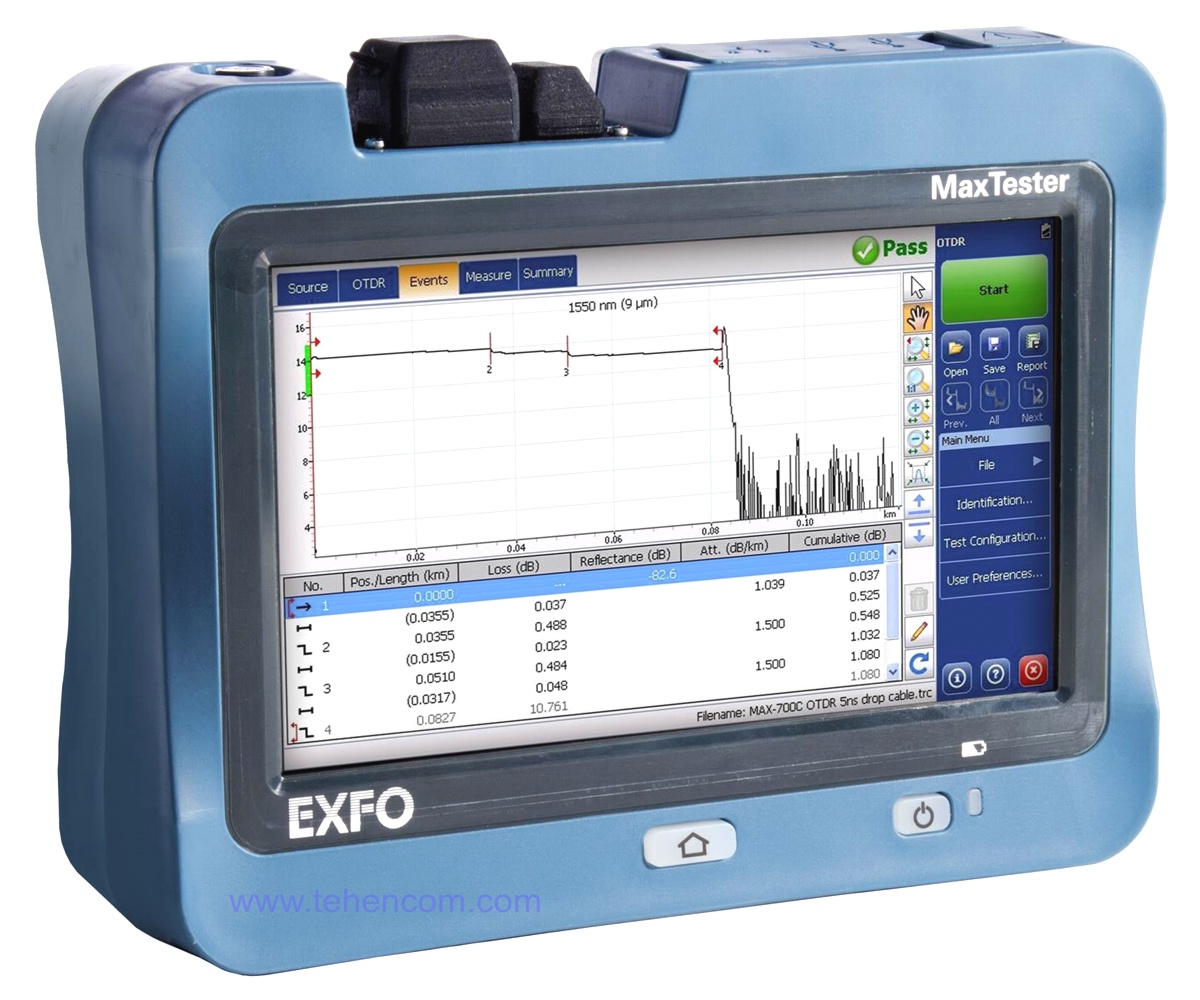
Product code: 1000264
Add item to cart. Our specialist will coordinate with you the complete set, tell you the price and delivery time.
Price on request
Out of production. Recommended replacement: EXFO MaxTester 700D series of optical time domain reflectometers
SHORT DESCRIPTION
A series of professional optical reflectometers MaxTester Canadian company EXFO is positioned as the main solution for any reflectometric measurements. The series includes models for singlemode, multimode and mixed networks. Models are available for passive and active fiber measurements, with a standard 36dB dynamic range (MAX-720C) and an improved 39dB (MAX-730C).
All EXFO MaxTester OTDRs feature high measurement accuracy, stable performance in harsh environments, and a variety of professional features to help you get the job done faster and better. This page details the main features of these devices. A complete description of all the characteristics of optical reflectometers EXFO MaxTester 720C and MaxTester 730C you can download below on this page in the section Documentation.
Main characteristics and models:
Multimode: 850 nm, 1300 nm, 29 dB (model MAX-720C-Q1).
Single mode: 1310 nm, 1550 nm, 36 dB (model MAX-720C-SM1).
Single mode: 1310 nm, 1550 nm, 39 dB (model MAX-730C-SM1).
Singlemode: 1310nm, 1550nm, 1625nm, 39 dB (model MAX-730C-SM3).
Single mode: 1625 nm, 39 dB (for active line) (model MAX-730C-SM6).
Single mode: 1650 nm, 39 dB (for active line) (model MAX-730C-SM7).
Multimode: 850 nm, 1300 nm and singlemode: 1310 nm, 1550 nm, 36 dB (MAX-720C-Q1-QUAD).
Single mode: 1310 nm, 1550 nm, 36 dB+ 1625 nm (for active line) (model MAX-720C-SM2).
Single mode: 1310 nm, 1550 nm, 39 dB+ 1625 nm (for active line) (model MAX-730C-SM2).
Single mode: 1310 nm, 1550 nm, 39 dB+ 1650 nm (for active line) (model MAX-730C-SM8).
Operating range on a real line: up to 105 km (for models 39 dB), up to 95 km (for 36 dB), up to 8 km (for multimode). Event Dead Zone (EDZ): 0.5 m.
Measurement of passive optical PON networks with splitters up to 1x128 (for 39 dB models).
Number of reflectogram points: up to 256,000. Built-in radiation source.
Built-in VFL illumination and built-in power meter (option VPM2X).
Advanced analysis and representation of a fiber link in the form of a diagram (option iOLM).
The reflectometer is Russified. Free software for PC.
2 GB of built-in memory (up to 20,000 reflectograms) + connection of flash drives.
Ability to connect video microscopes of the series EXFO FIP-400B.
17.8 cm widescreen touchscreen (800 x 480 resolution).
Interfaces: USB, Ethernet, Wi-Fi (RF option), Bluetooth (RF option).
Battery life: till 12 o'clock. Rugged and comfortable case design.
Weight: 1.5 kg. Dimensions: 166 x 200 x 68 mm. Working temperature: from -10°С to +50°С.
Compact and functional reflectometers for any optical networks
When buying an optical reflectometer, training can be provided (theory + practice)with the issuance of a personal certificate. When buying a set of equipment (for example reflectometer+fiber splicer) will receive an additional discount. All details can be found by phone: (044) 338-11-77, (097) 650-11-77, (095) 650-11-77, (093) 650-11-77.
Want a similar reflectometer, but cheaper? see model EXFO MaxTester 715B.
Want the same characteristics, but bigger screen? See measuring platform
EXFO FTB-1 Pro.
Need modular reflectometer? See measuring platforms EXFO FTB-2 Pro and EXFO FTB-4 Pro.
Do you want reflectometer Japanese company? See series Anritsu MT9083A2, B2 and C2.
Need comparable characteristics but cheaper? Watch the series Grandway FHO5000.
Need the cheapest reflectometer? Watch the series Grandway FHO3000.
Want to see the full list? Go to the main page by optical reflectometers.
DETAILED DESCRIPTION
Series of optical reflectometers EXFO MaxTester 720C came to replace the series Max Tester 720B, and the series EXFO MaxTester 730C came to replace the series MaxTester 730B, which was recognized as the best innovative product during exhibitions EEBC 2013 and expoTEL 2013 in Kyiv.
The 720C and 730C Series OTDRs currently in production have slightly improved performance over their predecessors, as well as more combinations of operating wavelengths. At the same time, all the strengths of the previous line are retained: a compact case, a large touch screen, long battery life, a Russified interface thought out to the smallest detail, and, most importantly, high reliability and measurement accuracy ensured in difficult real-life conditions. The appearance of the 720C and 730C series instrument is shown in this photo.
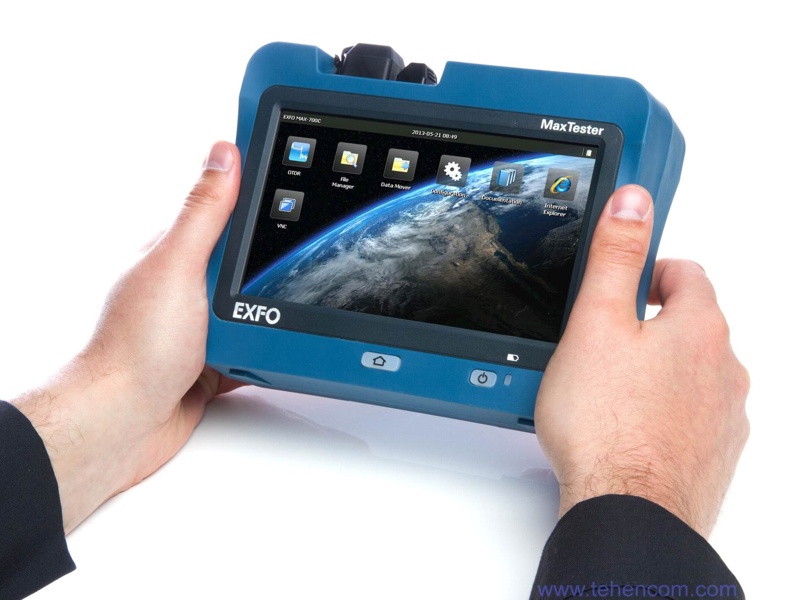
Optical Time Domain Reflectometer (OTDR) Mode
This is the main mode used by the EXFO MAX-720C and EXFO MAX-730C series reflectometers. Depending on the specific models, certain wavelengths are provided. For example, testing singlemode and multimode fibers is only supported by the MAX-720C-Q1-QUAD. And active fiber testing is supported by the MAX-720C-SM2, MAX-730C-SM2, MAX-730C-SM6, MAX-730C-SM7, and MAX-730C-SM8 models.
All models of these series allow you to select the duration of the test pulse in the range from 3 ns to 20 µs. Small pulses provide a minimum dead zone and are well suited for measuring short fibers, while large pulses are designed for long fiber optic trunks where maximum dynamic range is required from the reflectometer.
After measurements are taken, the MAX-720C and MAX-730C Series OTDRs automatically analyze the collected data and generate an event table that lists the range, loss, and reflection for each inhomogeneity found in the fiber (connectors, splices, splitters, macrobends, etc.). The quality of automatic analysis is so high that it completely eliminates all phantom events, reflections from connectors and other artifacts from the trace. And if necessary, you can conduct a manual analysis of any event using the two-point method or the four-point method. To do this, markers are used, the position of which is set by the user.
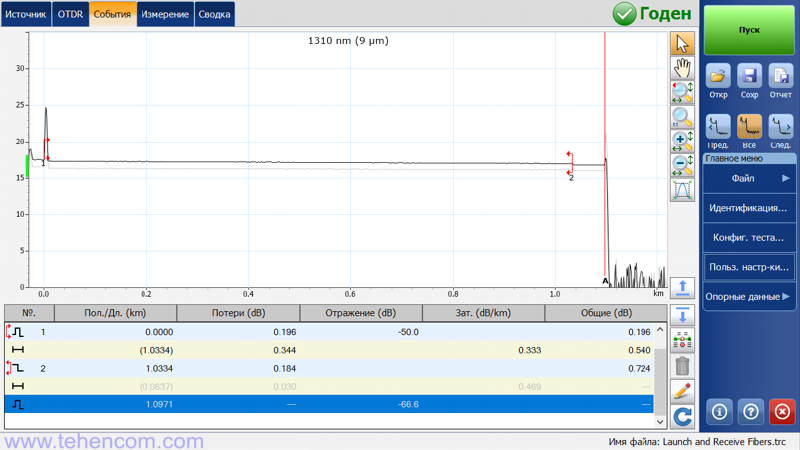
Advanced Fiber Link Analysis and Schematic View (option iOLM)
Trace display as daisy-chained event blocks (linear display) is a standard feature of the 720C and 730C series. But the iOLM function, which is available as an option, is much more powerful than the linear display mode. iOLM stands for intelligent Optical Link Mapper. When iOLM is running, the OTDR measures one fiber using several different test pulse values and combining all received reflectograms into one detailed scheme.
Using different values of the test pulse allows you to simultaneously obtain small dead zones, allowing you to test the beginning of the fiber in detail, and a large dynamic range, which is necessary for measuring the far end of a long fiber. When the iOLM function is running, in addition to the result in the form of a diagram, the measured reflectogram is also stored in the device's memory, which is convenient for compiling additional reports if they are required. An example of the iOLM option is shown in this screenshot, and a detailed description of this function in Russian is available below on this page in the section Documentation.

Measurement of passive optical PON networks
The MAX-720C and MAX-730C Series OTDRs are well suited for PON networks due to their remarkable performance. The MAX-720C series documentation states that they can measure PON networks with a total division ratio of 1x32, but as shown this is a comparative test, the 720C series does an excellent job even with a total division ratio of 1x64. And the older MAX-730C series easily measures from the subscriber to the OLT station through several splitters with a total division ratio of 1x128.
For measurements of PON network sections during construction, you can use the models of the MAX-720C and MAX-730C series with classic wavelengths of 1310 nm and 1550 nm. But if you plan to serve an already working (active) network, then models with a separate port and a built-in filter are needed. In this case, the working wavelength will be 1625 nm or 1650 nm. As an example, this screenshot shows the trace of a branch of a working PON network, measured from the subscriber's side. The branch contains three splitters with a total split ratio of 1x128. The measurements were carried out using an EXFO MAX-730C-SM8 optical reflectometer.
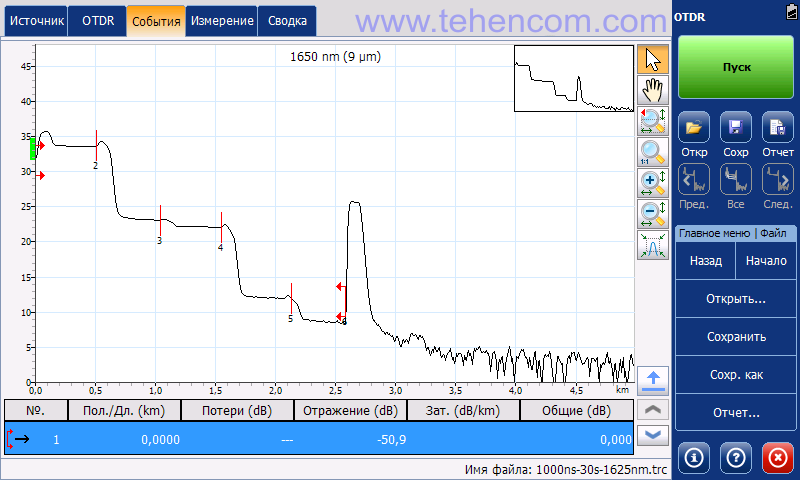
In this video, you can see the real work of the optical reflectometer model EXFO MAX-730C-SM8 when measuring a passive optical network at wavelengths of 1310 nm and 1550 nm. The tested PON network contains three splitters with a common division factor equal to 1x128. The plot combines the measurements of five different reflectometers. The MAX-730C-SM8 model is shown starting at the 9th minute and 10th second of this video.
Checking the quality of optical connectors
Checking the purity and quality of optical connectors is a mandatory requirement for the operation of modern networks. MAX-720C and MAX-730C series reflectometers have the ability to directly connect optical video microscopes EXFO FIP-400B, which can fully automatically focus, center the image and check the connector for the presence and degree of contamination and defects. At the same time, the reflectometer is used as a means of displaying, processing and storing the obtained photographs.
This figure shows an example of the operation of the EXFO FIP-400B video microscope together with the EXFO MaxTester reflectometer. In the central part of the screen, an optical connector is shown, which, due to contamination, was recognized by the automatic analysis program as non-compliant (unusable). The program marked micro-pollutions with red dots, which in this case served as the reason for such a decision.

Design of optical reflectometers EXFO MaxTester 720C and 730C
The EXFO MaxTester 720C series and EXFO MaxTester 730C series reflectometers are made in a compact case, 166 x 200 x 68 mm in size and weighing 1.5 kg. All optical connectors and other connectors are protected by individual covers, which increases the reliability of the reflectometer and ease of use. The operating temperature at which measurements can be taken is between -10°C and +50°C.
The reflectometers are equipped with a high-quality touch screen with a diagonal of 17.8 cm and a resolution of 800 x 480 pixels. To accommodate the stylus, a separate slot is provided in the instrument case. The battery is located inside the case, its charge is enough for 10-12 hours of full-fledged work. There are no air vents and no cooling fans in the case, which increases reliability and ensures quiet, comfortable operation.
This photo shows the top side of the OTDR case, where all the connectors are located. This is the EXFO MAX-720C-Q1-QUAD model. On the top left is an APC polished single-mode port (square with a green border). At the top right is a UPC polished multimode port (square with gray rim). The stylus is on the bottom left. To the right of it is the VPM2X option (built-in power meter and VFL illumination). At the bottom right, under a rubber protective cover, are the USB and Ethernet connectors. The rightmost rubber cover with an exclamation mark protects the reflectometer's power connector.
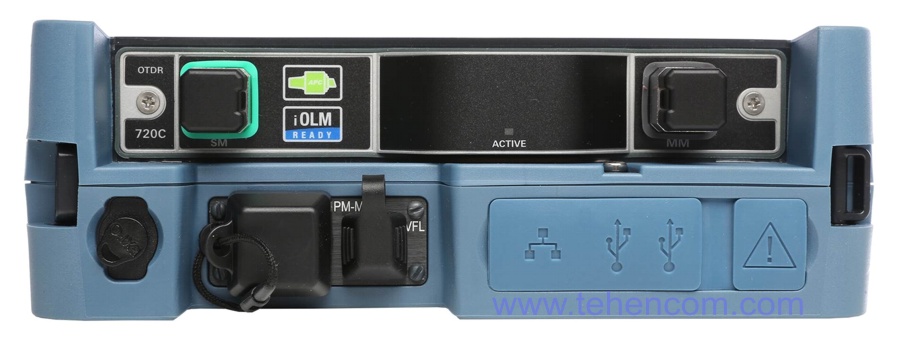
And this photo shows the top side of the body of the EXFO MAX-730C-SM8 optical reflectometer. At the top left is a single-mode port with APC polishing and wavelengths of 1310 nm and 1550 nm (square with a green rim). At the top right is the second single-mode port with a filter and an operating wavelength of 1650 nm, designed to test the active fiber. This port also has an APC finish, as indicated by the green rim around its connector. The stylus is on the bottom left. To the right of it is the VPM2X option (built-in power meter and VFL illumination). At the bottom right, under a rubber protective cover, are the USB and Ethernet connectors. The rightmost rubber cover with an exclamation mark protects the reflectometer's power connector.
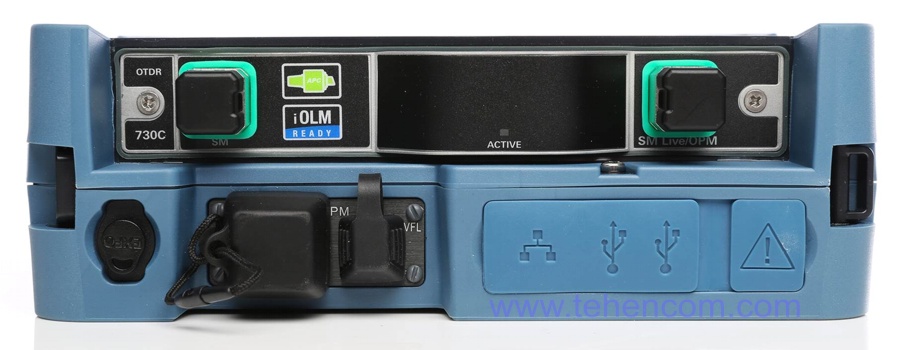
Specifications for EXFO MaxTester 720C and 730C Series Optical Reflectometers
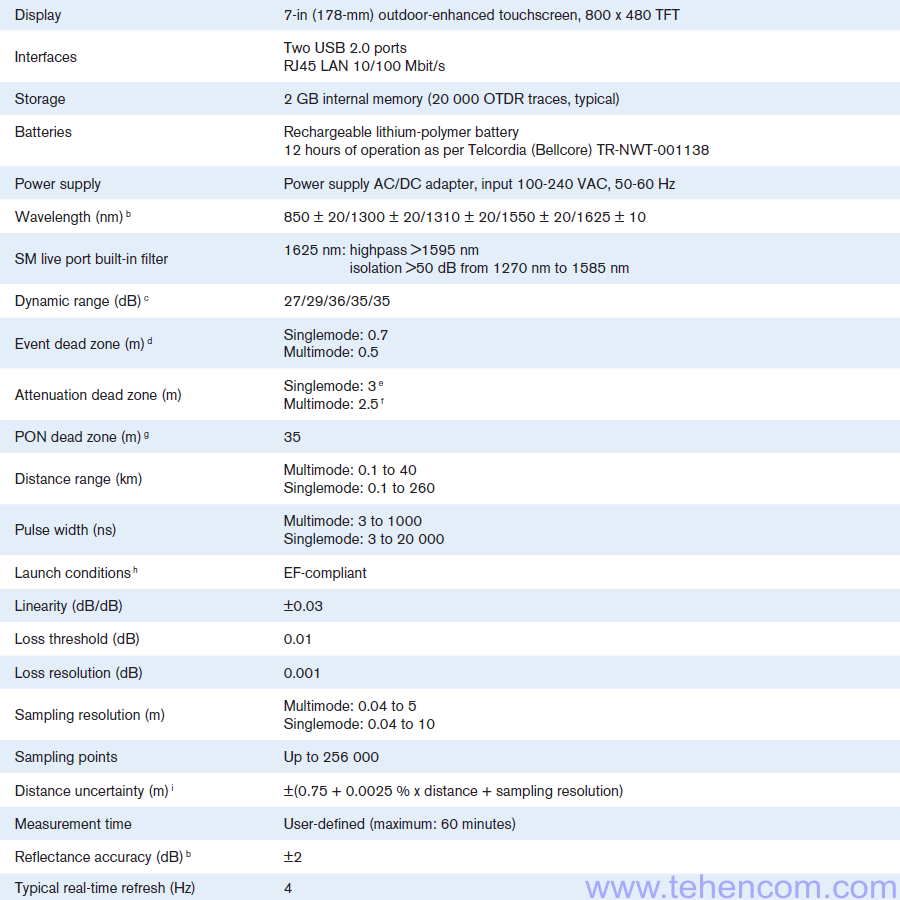

For a complete list of technical characteristics of optical reflectometers EXFO MaxTester 720C and EXFO MaxTester 730C, see below on this page in the section Documentation.
Delivery set of optical reflectometers EXFO MaxTester 720C and 730C
| Name | Short description |
| EXFO MAX-720C-SM1 | Optical reflectometer with one connector and wavelengths: 1310 nm (36 dB) and 1550 nm (35 dB). |
| or | |
| EXFO MAX-720C-SM2 | Optical reflectometer with two connectors and wavelengths: the first connector 1310 nm (36 dB), 1550 nm (35 dB) and the second connector with a filter 1625 nm (35 dB). |
| or | |
| EXFO MAX-720C-Q1 | Optical reflectometer with two connectors and wavelengths: the first connector is 850 nm (27 dB) and 1300 nm (29 dB). Only the first connector is active. Ready for subsequent activation with the software option of a second connector with wavelengths: 1310 nm (36 dB) and 1550 nm (35 dB). |
| or | |
| EXFO MAX-720C-Q1-QUAD | Optical reflectometer with two connectors and wavelengths: the first connector 850 nm (27 dB), 1300 nm (29 dB) and the second connector 1310 nm (36 dB) and 1550 nm (35 dB). |
| or | |
| EXFO MAX-730C-SM1 | Optical reflectometer with one connector and wavelengths: 1310 nm (39 dB) and 1550 nm (38 dB). |
| or | |
| EXFO MAX-730C-SM2 | Optical reflectometer with two connectors and wavelengths: the first connector 1310 nm (39 dB), 1550 nm (38 dB) and the second connector with a filter 1625 nm (39 dB). |
| or | |
| EXFO MAX-730C-SM3 | Optical reflectometer with one connector and wavelengths: 1310 nm (39 dB), 1550 nm (38 dB) and 1625 nm (39 dB). |
| or | |
| EXFO MAX-730C-SM6 | Optical reflectometer with one filter connector and wavelength: 1625 nm (39 dB). |
| or | |
| EXFO MAX-730C-SM7 | Optical reflectometer with one filter connector and wavelength: 1650 nm (39 dB). |
| or | |
| EXFO MAX-730C-SM8 | Optical reflectometer with two connectors and wavelengths: the first connector 1310 nm (39 dB), 1550 nm (38 dB) and the second connector with a filter 1650 nm (39 dB). |
| plus for all models: | |
| GP-2242 | Strap |
| GP-2209 | Battery (Installed inside the OTDR) |
| GP-2243 | Power supply 20 W |
| GP-10-061 | Soft carry bag |
| - | Stylus |
| - | Calibration certificate |
| - | CD with electronic documentation |
| - | 1 year warranty (can be extended to 3 and 5 years) |
Options and accessories for optical reflectometers of the EXFO MaxTester 720C and 730C series
The two pictures below show a list of options that can be equipped with the MaxTester 720C and 730C series reflectometers. The first thing to do when placing an order is to select a reflectometer series (MAX-720C or MAX-730C) and a set of wavelengths (SM1, SM2, Q1-QUAD, etc.). Next, you need to select the operating mode: only the reflectometer (option OTDR), only the representation of the fiber line in the form of a diagram (option iOLM) or both modes (option Oi). Next, you need to select the type of polishing of the OTDR input connector: APC corner polishing with reduced reflection (EA option) or UPC regular polishing (EI option). If you need a built-in power meter that is compatible with the OTDR port for active fiber measurements, then add the OPM or OPM2 option. Further, you can add advanced functionality of the iOLM mode (options iADV,
You can also add an integrated power meter (Option PM2X) or an integrated power meter and VFL illumination (Option VPM2X). The built-in power meter connector type is determined by the FOA option. Option FR2 is a measurement post-processing program with many automation functions. When ordering the RF option, the reflectometer comes with built-in WiFi and Bluetooth. Next come the optical video microscope options FIP-400B, which can be connected directly to the USB port of the reflectometer, and attachments to it. See the full list of options and accessories for the EXFO MaxTester 720C and EXFO MaxTester 730C optical reflectometers below on this page in the section Documentation.


Of the additional accessories that can be equipped with MaxTester 720C and 730C reflectometers, it is worth noting: a hard carrying case (option GP-10-100), a backpack for the instrument and accessories (option GP-2155) and an adapter from 2.5 mm to 1 .25 mm for built-in VFL light (accessory GP-1008).
Documentation
This PDF documentation contains the most complete description of the EXFO MaxTester 720C and 730C professional optical reflectometers, their technical characteristics and operating modes:
Description and characteristics of the EXFO MaxTester 720C series (in English) (10 pages; 2 MB)
Description and characteristics of the EXFO MaxTester 730C series (in English) (9 pages; 2 MB)
EXFO MaxTester OTDR User Manual (in Russian) (185 pages; 7 MB)
User's Guide for Reflectometric Measurements (in Russian) (250 pages; 6 MB)
iOLM Measurement User Guide (in Russian) (237 pages; 6 MB)
And here you can find our tips and other useful information on this topic:
1310nm and 1550nm Reflectometer Selection for Passive Optical PON Networks
Comparative table of the main characteristics of optical reflectometers
How to buy equipment cheaper - discounts, special prices, demo and used devices
To simplify the process of choosing an optical reflectometer, you can use our experience and recommendations. We have over 20 years of practical supply experience and can immediately answer many questions about models, options, delivery times, prices and discounts. This will save your time and money. For this it's simple call us or write to us at Email and we will be happy to answer your questions.